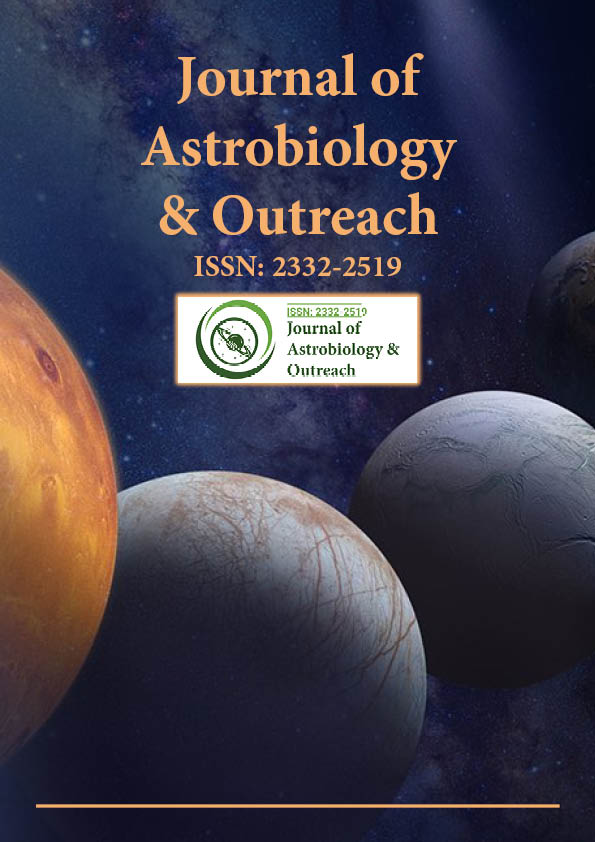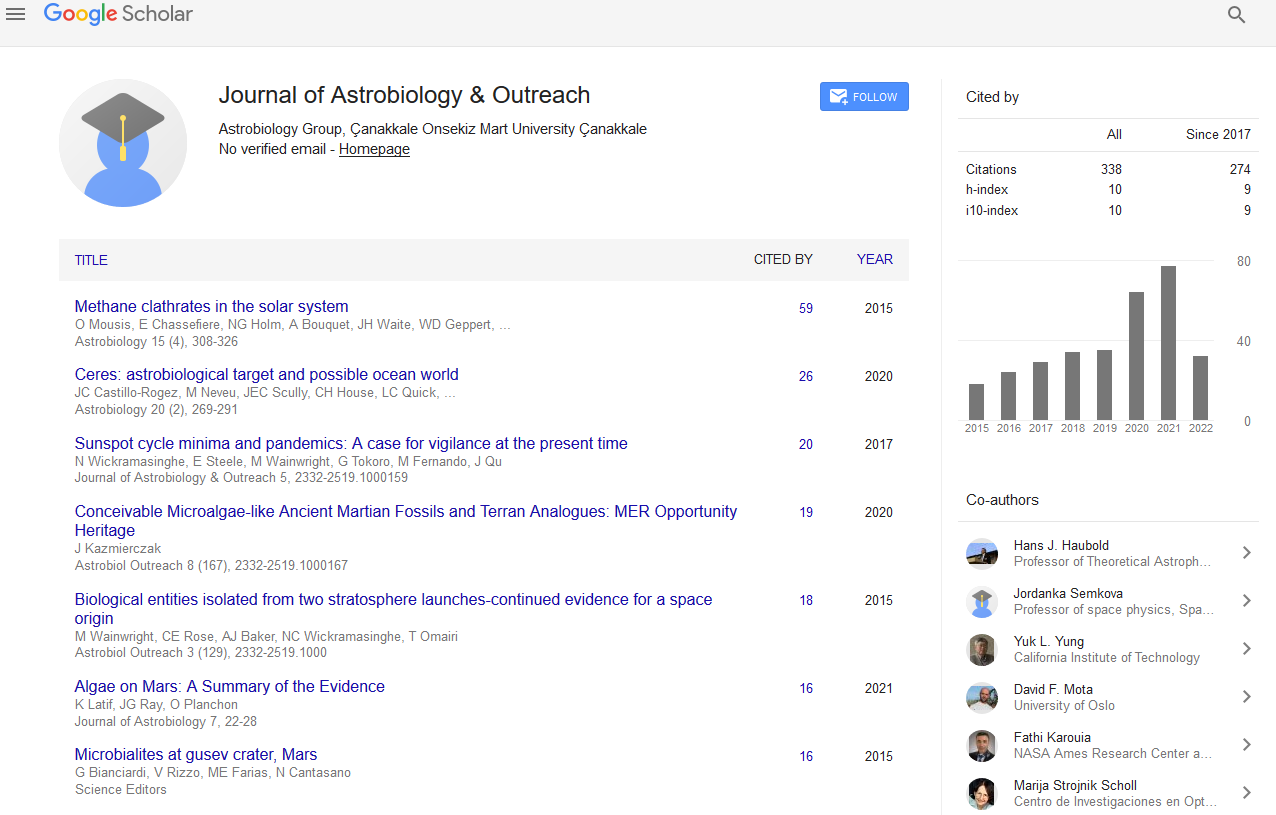Indexed In
- Open J Gate
- Academic Keys
- JournalTOCs
- RefSeek
- Hamdard University
- EBSCO A-Z
- OCLC- WorldCat
- Google Scholar
Useful Links
Share This Page
Journal Flyer

Open Access Journals
- Agri and Aquaculture
- Biochemistry
- Bioinformatics & Systems Biology
- Business & Management
- Chemistry
- Clinical Sciences
- Engineering
- Food & Nutrition
- General Science
- Genetics & Molecular Biology
- Immunology & Microbiology
- Medical Sciences
- Neuroscience & Psychology
- Nursing & Health Care
- Pharmaceutical Sciences
Short Communication - (2024) Volume 12, Issue 4
Nanodosimetric Study of Galactic Cosmic Rays: Assessing Radiation Risks for Lunar Exploration
Alexandre Dupont*Received: 29-Nov-2024, Manuscript No. JAO-24-28020; Editor assigned: 02-Dec-2024, Pre QC No. JAO-24-28020 (PQ); Reviewed: 16-Dec-2024, QC No. JAO-24-28020; Revised: 23-Dec-2024, Manuscript No. JAO-24-28020 (R); Published: 30-Dec-2024, DOI: 10.35248/2332-2519.24.12.370
Description
The study of Galactic Cosmic Rays (GCRs) is significant in understanding the potential health risks associated to astronauts during extended space missions, especially those involving lunar exploration. The presence of high-energy protons and alpha particles within GCRs is a significant concern due to their ability to penetrate human tissue and cause cellular damage [1]. As space agencies like NASA prepare for manned missions to the Moon, it is important to investigate how these particles interact with the biological tissues of astronauts [2]. This communication discusses a multiscale nanodosimetric study aimed at understanding the effects of GCR protons and alpha particles on the organs of astronauts stationed on the lunar surface.
GCRs consist primarily of highly energetic protons (about 87%) and heavier ions such as alpha particles (about 12%) and other nuclei (1%). These particles, originating from outside our solar system, present a significant radiation risk due to their high penetration capabilities [3,4]. In the lunar environment, where there is minimal atmospheric protecting and no magnetic field, astronauts are exposed to higher levels of GCRs compared to Earth’s surface. A detailed understanding of how these particles interact with human tissues, especially at the molecular and cellular levels, is critical for assessing the long-term health risks to astronauts, including cancer, cardiovascular diseases, and potential damage to the central nervous system.
Traditional dosimetry methods have primarily focused on macroscopic or organ-level radiation dose estimates [5]. However, these methods do not capture the full complexity of radiation interactions, particularly at the nanoscopic level, where radiation-induced damage can be more directly linked to biological outcomes. Nanodosimetry, a field that connects the gap between radiation physics and cellular biology, provides the necessary tools to study the nanoscale effects of ionizing radiation. This approach allows for the analysis of energy deposition at a level that is more relevant to the biological processes involved in radiation damage [6,7].
In this study, a multiscale nanodosimetric approach was described to investigate the behavior of GCR protons and alpha particles as they pass through the organs of astronauts on the lunar surface. The study combined both Monte Carlo simulations and experimental data to create a model that predicts how different organs-such as the brain, lungs, liver, and bone marrow-would respond to GCR exposure [8,9]. The simulations were run to estimate energy deposition patterns, radiation track structures, and the resulting damage at a cellular level, while experimental data provided validation of the theoretical models.
One of the primary findings of this study is the differential effect of proton and alpha particle exposure across various tissues. Alpha particles, due to their larger mass and charge, exhibit a much higher Linear Energy Transfer (LET) compared to protons [10]. This higher LET is associated with more localized energy deposition, which can lead to greater biological damage in targeted cells. In contrast, protons, though more penetrating, tend to cause less localized damage. This difference has significant implications for risk assessments, particularly for organs such as the brain and bone marrow, where the effects of high-LET radiation could be particularly detrimental due to their critical functions in health maintenance.
The study also highlights the importance of understanding the spatial distribution of radiation-induced damage. By describing multiscale techniques, the researchers were able to map out radiation-induced damage at the nanoscale level, identifying "hot spots" where the greatest levels of energy deposition occur. These hot spots are where the most severe DNA damage, including double-strand breaks, is likely to happen, leading to the potential for mutations and long-term health risks, including cancer.
Conclusion
In conclusion, this study represents a significant step forward in our understanding of GCR interactions with human tissues in space, particularly in the context of lunar exploration. By utilizing nanodosimetry and multiscale modeling, the research provides a more detailed and accurate picture of radiation risk, create the path for more effective countermeasures in future manned space missions. As we prepare for next great leap onto the Moon, studies like this are significant to ensuring the safety and well-being of astronauts as they face the challenges of space radiation.
References
- Archer JW, Large MJ, Bolst D, Sakata D, Tran HN, Chatzipapas KP, et al. A multiscale nanodosimetric study of GCR protons and alpha particles in the organs of astronauts on the lunar surface. Radiat Phys Chem. 2024;229:112448.
- Harmon K, Arnold B, Levesque M, Johnston M, Lichten S, Lock P, et al. Pre-launch lessons learned from NASA’S deep space network support for the artemis I mission to the moon. Acta Astronautica. 2023;210:589-95.
- Cagnoli I, Kyratzis D, Serini D, HERD collaboration. HERD space mission: Probing the galactic cosmic ray frontier. Nucl Instrum Methods Phys Res A. 2024;1068:169788.
- Boschini MJ, Cavallotto G, Torre DS, Gervasi M, Vacca GL, Rancoita PG, et al. Fast and accurate evaluation of deep-space galactic cosmic ray fluxes with HelMod-4/CUDA. ASR. 2024;74(9):4302-4320.
- Pria DGL, Sohier O, Scirè C, Urso RG, Baratta GA, Palumbo ME. Experimental study on the radiation-induced destruction of organic compounds on the surface of the Moon. Icarus. 2024;415:116077.
- Caprioli C, Mazzucconi D, Bortot D, Agosteo S, Pola A, Rastelli D, et al. Numerical tools for simulating low-energy electron interactions in experimental nanodosimetry applications. Radiat Meas. 2024;177:107265.
- Li WB, Hofmann W, Friedland W. Microdosimetry and nanodosimetry for internal emitters. Radiat Meas. 2018;115:29-42.
- Edalatkhah E, Badiei S. Dose mapping of an irradiation chamber of a gamma cell unit using Fricke gel dosimeters and Monte Carlo simulation. Appl Radiat Isot. 2024;217:111631.
- Jia SB, Shamsabadi R, Mogheiseh L, Baghani HR. Assessment of secondary cancer risks within non-target organs during proton therapy for lung cancer: A Monte Carlo study. Appl Radiat Isot. 2024;214:111532.
- Lee KM, Lee US, Kim EH. A practical alpha particle irradiator for studying internal alpha particle exposure. Appl Radiat Isot. 2016;115:304-11.
Citation: Dupont A (2024). Nanodosimetric Study of Galactic Cosmic Rays: Assessing Radiation Risks for Lunar Exploration. J Astrobiol Outreach. 12:370.
Copyright: © 2024 Dupont A. This is an open-access article distributed under the terms of the Creative Commons Attribution License, which permits unrestricted use, distribution, and reproduction in any medium, provided the original author and source are credited.

